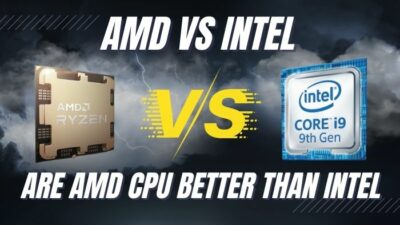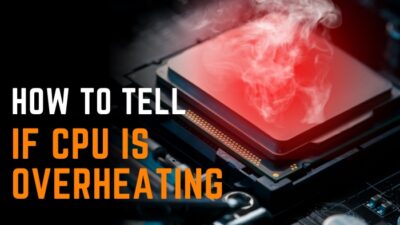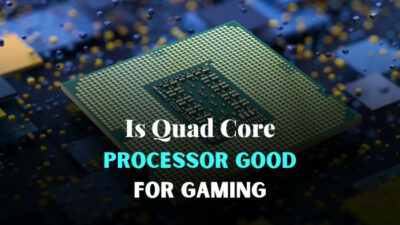Intel has been reigning supreme in the CPU market for almost half a century with thousands of marvelous processors.
Yet naming the CPUs was a challenge for Intel, and undoubtedly they failed as the names tell nothing about a processor.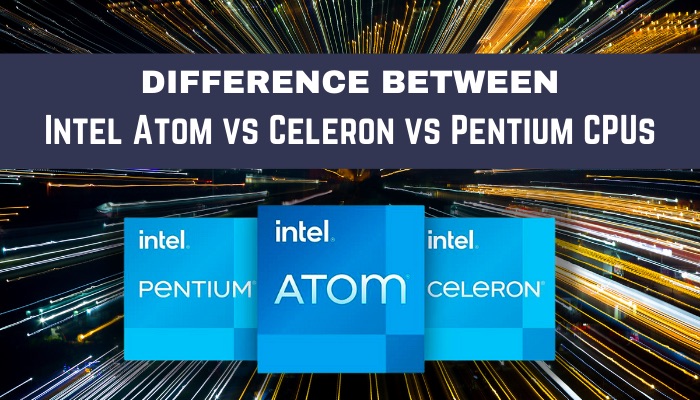 Intel has three lineups for the low-end processor segment: Atom, Celeron, and Pentium. It is confusing to choose a CPU from these vast alternatives.
Intel has three lineups for the low-end processor segment: Atom, Celeron, and Pentium. It is confusing to choose a CPU from these vast alternatives.
However, this article will eliminate all the confusion and assist you in selecting a suitable processor.
What’s the Difference Between Atom, Celeron, and Pentium CPUs?
Intel Atom is a tiny processor that uses ultra-low voltage and is compatible with portable devices, such as mobile, ultrabooks, and tablets. Celeron is a low-budget series that mainly focuses on laptops and mobiles. Pentium is close to the Core i3 series and provides a smoother experience.
If you want to compare the Atom, Celeron, and Pentium processors based on performance, the sequence will be Pentium > Celeron > Atom.
Note: Intel 7th gen Pentium processors have achieved about 95% performance of Intel Core i3 processors.
Intel builds Pentium or Celeron processors on two different technologies: Atom-based and Core-based.
To find out whether the processor is Atom-based or Core-based, look at the model of your chip. If your Pentium or Celeron processor has N and J in front of the model number, it’s Atom-based. On the other hand, if the model number has G in the front of the name, it’s Core-based.
Consider the following discussion to understand the differences between the Atom vs. Celeron vs. Pentium CPUs.
1. Intel Atom Processor
Though Intel is the top processor manufacturer for almost all devices, it was far beyond the enormous mobile processor industry.
In 2008, Intel introduced its new processor, Atom, to beat the mobile processors manufacturers, such as Qualcomm Snapdragon, Apple Bionic, and Samsung Exynos.
Unfortunately, Intel could not cope with other mobile processor manufacturers and discontinued the Atom processor lineup in 2016. The most valuable product that came with the Atom processor was a netbook.
But with time, the netbooks were replaced by other tablets and Chromebooks because of the affordable and compact designs.
However, Intel is still making Atom processors for Servers, Cellular Infrastructure Applications, and IoT devices.
Check out our separate post on how to enable all CPU cores in Windows 11.
2. Intel Celeron Processor
If you are looking for an efficient and ultra-budget computer processor, the best available option is the Intel Celeron Processor.
It is the low-end processor you may find available in the Intel processor lineup. Celeron processors are mainly dual-core CPUs without any enabled hyperthreading. A Celeron processor consists of two cores and two threads.
Intel Celeron CPUs have two different lineups for desktops and laptops. G series processors are for Desktops, and the N series processors are for laptops.
The desktop-based Celeron processors are comparatively more powerful than the laptop-based Celeron processors. Additionally, the desktop-based Celeron processors offer much higher TDP (Thermal Design Power) in watts.
Consider the following table for the most affordable and powerful Celeron CPUs:
| Processor Name | Benchmark Score | Note | Type | TDP | Configuration |
|---|---|---|---|---|---|
| Intel Celeron N4020 | 1606 | Released in 2019, used on many laptops | Laptop | 6W | 2 Core, 2 Thread (1.10-2.80 GHz) |
| Intel Celeron N4500 | 2060 | Value based Celeron CPU | Laptop | 6W | 2 Core, 2 Thread (1.10-2.80 GHz) |
| Intel Celeron N5100 | 2540 | Flagship; four core CPU | Laptop | 6W | 4 Core, 4 Thread (1.10-2.80 GHz) |
| Intel Celeron G5905 | 2846 | Desktop-based flagship CPU | Desktop | 58W | 2 Core, 2 Thread (3.50 GHz) |
The table above represents the performance data of most recent and popular Celeron processors.
Even the weakest Intel Celeron N4020 is much more powerful than the Intel Atom processors in terms of performance.
So, when comparing any Celeron CPUs with other models, you should pick a model that is available for comparison. For example, the Intel Celeron N5100 CPU is the most powerful in the Celeron series but is infrequent and unsuitable for comparison.
Instead, you can pick the Intel Celeron N4020 CPU for a better comparison result.
Let’s quickly look at the Celeron CPUs’ usage:
- Basic web browsing
- Watching Movies and TV Shows
- Basic Word, Excel, and PowerPoint use
- Emailing
- Social media use
If the above usage meets your requirements, you can choose the most suitable one without hesitation. Otherwise, keep scrolling to find the best Pentium processor for you.
You should check our guide on whether a Celeron CPU is good for gaming.
3. Intel Pentium Processor
For basic productivity tasks, the perfect choice is the intel Pentium processor series.
The Pentium processor series is far behind the next Intel Core i3 lineup. But if you want a CPU that can effortlessly handle most basic tasks with light gaming, the Pentium series is way better than the Celeron processor.
While the Celeron processors are laggy and lack performance, the Pentium processors offer a smoother performance. The latest Pentium CPUs are also good for gaming.
Before the Intel Core series, the Pentium processors were Intel’s top-tier. Intel divided the Pentium series into two lineups: Pentium Silver and Pentium Gold. It makes the Pentium lineup more complex.
Pentium Silver Processor
Intel Pentium Silver CPU is the modified version of the Celeron processors. Some of them even belong to the same Intel Gemini Lake generation.
The Pentium Silver and Gold series was created for a different product category. The Silver series comes with pre-built devices. So, you cannot find a Silver series processor on a shelf to buy separately.
Check the following table for the latest Pentium Silver CPUs:
| Processor Name | Benchmark Score | Processor Type | TDP | Notes | Configuration |
|---|---|---|---|---|---|
| Intel Pentium Silver N6005 | 3224 | Laptop/ Mobile | 10W | Flagship CPU | 4 Core, 4 Thread (2.0-3.30 GHz) |
| Intel Pentium Silver N5030 | 2637 | Laptop/ Mobile | 6W | Popular CPU | 4 Core, 4 Thread (1.1-3.10 GHz) |
Pentium Gold Processor
The Pentium Gold series processors are very close to the Core i3 processor. They even share the same design architecture.
But the Gold series offers fewer cores, clock speed, and TDP compared to the Core i3 processors. It makes the Gold series more power efficient and suitable for mobile and tablets.
Quick Note: The Pentium Gold series is not superior to the Intel Silver CPUs. Sometimes, the Gold series is even worse than the Silver series, particularly in the mobile segment.
However, the Gold series is superior compared to the Atom, Celeron, and Pentium Silver for the desktop CPUs. It is still the best-performing CPU than the others.
Consider the following table for the latest Pentium Gold CPUs:
| Processor Name | Benchmark Score | Processor Type | TDP | Notes | Configuration |
|---|---|---|---|---|---|
| Intel Pentium G6400 | 4155 | Desktop | 58W | Popular | 2 Core, 4 Thread (4.0 GHz) |
| Intel Pentium G6600 | 4396 | Desktop | 58W | Flagship | 2 Core, 4 Thread (4.2 GHz) |
Pentium Gold series uses hyperthreading technology that makes the processor more efficient and helps to save power.
Pentium Gold 6405U CPU (designed for laptops) is inferior to most Pentium CPUs and even some mobile-grade Celeron CPUs.
Let’s have a look at the Pentium CPUs’ usage:
- Multitasking (You can open different applications or multiple browser windows at a time)
- Basic gaming (League of Legends, Minecraft, Need for Speed, etc.)
- Productivity tools use (Basic editing)
Recommendation: For an entry-level desktop build, desktop-based Intel Pentium Gold processors are highly recommended.
Intel Atom Vs. Celeron Vs. Pentium Processors Performance Benchmarks
Benchmark is a computational process that runs a set of computer programs for measuring the comparative performance of a processor. The benchmark clearly shows the processor’s performance to understand the capability compared to other processors.
Consider the following image that shows the Passmark score of various Intel processors. I have also added a Core i3 CPU for better understanding.
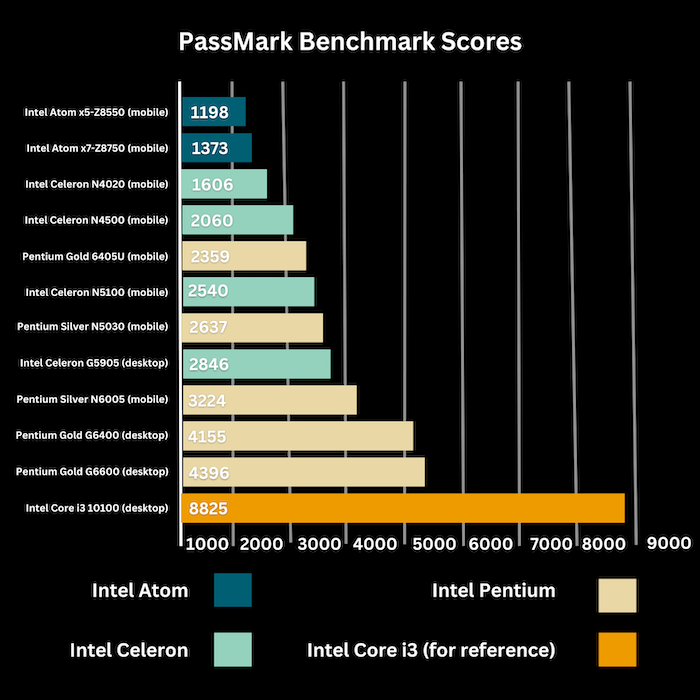
The image above clearly shows the Passmark scores for Intel Atom, Celeron, and Pentium processors. Besides, you should also check the processor’s specifications to understand the differences better.
Intel Atom Vs. Celeron Vs. Pentium Processors Specifications
Having a quick look at the processor’s specifications can instantly provide an idea about the benefits of using that processor.
The following specifications table will cover the cache size, clock speed, power consumption, and memory type.
Let’s have a look at Intel Atom, Celeron, and Pentium processor’s specifications:
| Processor Name | Cache | Clock speed | Power | Memory |
|---|---|---|---|---|
| Intel® Pentium® Processor N3710 | 2 MB | up to 2.56 GHz | 6 W | DDR3L-1600 |
| Intel® Celeron® Processor N3160 | 2 MB | up to 2.24 GHz | 6 W | DDR3L-1600 |
| Intel® Celeron® Processor N3060 | 2 MB | up to 2.48 GHz | 6 W | DDR3L-1600 |
| Intel® Celeron® Processor N3010 | 2 MB | up to 2.24 GHz | 4 W | DDR3L-1600 |
| Intel® Atom™ Processor x5-E8000 | 2 MB | up to 1.04 GHz | 5 W | DDR3L-1600 |
| Intel® Atom™ Processor x5-Z8350 | 2 MB | up to 1.92 GHz | 2 W | DDR3L-RS 1600 |
There is not very much difference between the Celeron and Pentium N series processors. However, the Pentium processors have an advantage with the clock speed.
On the other hand, the Atom processors are far behind compared to the Celeron and Pentium N series processors. Since these are all dual-core CPUs, you should know how good dual-core processors are in terms of gaming.
Which Intel CPU is Right for You?
The best Intel CPU is highly dependent on your use cases. If you are looking for a CPU that offers the best battery life, lower heat dissipation, and less performance, then the Pentium Silver (Pentium/Celeron N and J series) is the right choice.
In case you need a CPU for multitasking with high performance, then the most suitable CPU for you is the Pentium G series.
However, not every Pentium G series processor is powerful enough compared to Celeron CPUs. For instance, Intel Pentium Gold 6405U is a laptop-based CPU. It is inferior to the Pentium Silver CPUs and some mobile-grade Celeron processors.
So, while choosing the best CPU for your laptop or desktop computer, you must find the use cases first, and then you can efficiently pick the right one from the vast CPU models.
Since we’re discussing low-end CPUs, you should definitely check out our extended review on Ryzen 3’s gaming performance.
Frequently Asked Questions
Which is better, Pentium or Atom?
The Atom processors are energy efficient, so they cannot generate much power. However, the Atom processor can run on mobile devices for low power consumption. On the contrary, Pentium processors are more potent than Atom processors.
Is Intel Atom better than Intel Celeron?
The Atom processor is comparatively slower than the Celeron processor. As the Atom processors are power efficient, they cannot provide enough power compared to the Celeron processors.
Is Pentium better than Celeron?
In recent years, Pentium processors adopted a new technology called hyper-threading. That helps the Pentium to split every single core into two, which can perform like a quad-core processor. And the Celeron processors are missing this great feature.
Final Thoughts
The difference between the Intel Atom vs. Celeron vs. Pentium is subtle. Picking the right one is dependent on your use cases and budget.
Pentium processors can multitask efficiently when the Celeron processors focus on basic computing. On the other hand, the Atom CPUs are suitable for mobile and tablets for their low-power consumption.
I hope this article clarifies the differences between Intel’s Atom, Celeron, and Pentium CPUs with the guideline to pick the right one for you.

